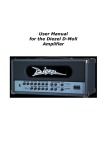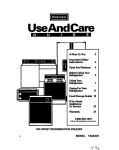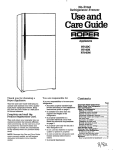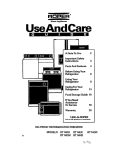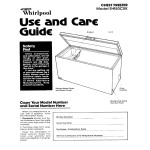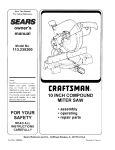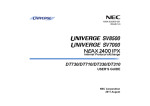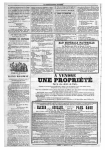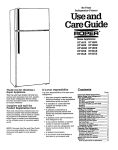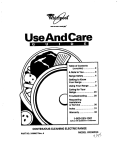Download Whirlpool RT14DM Specifications
Transcript
A Note To You 2 Important Safety Instructions 3 Parts And Features 4 Before Using Your Refrigerator 5 Using Your Refrigerator 7 Cating For Your Refrigerator 13 Food Storage 76 Guide If You Need Assistance Or Service 18 Warranty 20 l-800-44-ROPER Call US with NO-FROST A questions or comments. REFRIGERATOR-FREEZERS MODELS RT14DK RT14DM RTl4GD RT14HK A Note To You Thank you for buying a Roper@ applliance. You purchased a quality, wofti-c/ass home appliance. Years of engineering experience went into its manufacturing. To ensure that you enjoy m#enyyears of trouble-free operation, we developed this Use and Care Guide. It is full of valuable information on how to operate and maintain your appliance properly and safely. Pleas,e read it carefully. Also, please complete and mail the Ownership Registration Card provkM with your appliance. This will help us noMy you about any new information on your appli snce. Your safety is important to us. This guide contains safety symbols and statement: ;. Please pay special attention to these symbols and follow any instructions given. Here is B brief explanation of the use of each symbol. This symbol will help you avoid actions This symbol will help alert you to such Our toll-free is available number, 24 hours 1-800-44-ROPER a day. (l-800447-67371, If you ever have a question concerning your appliarce’s operation, or if you need service, first see ‘If You Need Assistance Or Service” on page 18. If you need further help, feel free to call us. When calling, you will need to know your appliiixe’s complete model number and serial number. You can find this information on the model and serial number label (see diagrams on page 4). For your convenience, we have included a handy place below for you to record these numbers, the purchase date from the sales slip and your dealer’s name and telephone number. Keep this book and the sales slip together in a safe place for future reference. Model Number Dealer Name Serial Number Dealer Phone Pun: hase Date 2 Important Safety Instructions 1 To reduce the risk of We, electrkal shock, or injury when using your refrigeratolm8,follow these basic precautions: Read all insttuctions before using the refrigerator. *Child entrapment and suffocation are not problems of the past. Junked or abandoned refrigerators are still dangerous . . . even if they will “just sit in the garage a few days.” If you are getting rid of your oki refrigerator, do it safely. Please read the enclosed safety booklet from the Association of Home Appliance Manufacturers. Help prevent accidents. l I Help Never allow children to operate, play with, cir crawl inside the refrigerator. .Never clean refrigerator parts with f lamrnable fluids. The fumes can create a fire hazard or explosion. l FOR YOUR SAFETY l Do NOT STORE OR USE GASOLINE OR O’l-HER FLAMMABLE VAPORS AND LIQUIDS IN THE VICINITY OF THIS OR AMY OTHER APPLIANCE. THE FUMES CAN CREATE A FIRE HAZARD OR EXPLOSION. l - SAVE THESE INS’I’RUCTIONS - us help you Please: l Install and level the refrigerator on a floor that will hold the weight and in an area suitable for its size and use. l Do not install the refrigerator next to an oven, radiator or other heat source. l Do not use the refrigerator in an area where the room temperature will fall below 55°F (13°C). l Keep the refrigerator out of the weather. l Connect the refrigerator only to the proper kind of outlet with the correct electrical supply and grounding. (Refer to the Electrical Requirements and Grounding Instructions Sheet.) . Do not load the refrigerator with food before it has time to get properly cold. l Use the refrigerator only for the uses described in this manual. l Properly maintain the refrigerator. l Be sure the refrigerator is not used by anyone unable to operate it properly. Parts And Features This section contains cadioned illustrations of your appliance. Use them to become familiar with where all parts and ieatures are located a;ld &ithey kmk like. Automatic ke maker (RTl4DM only not shown) ke cube ---a- (RTl4DK, RT14GD and RTWiK) Part&l / freezer shelf - Butter compartment 7 Adjustable wire shelves Control panel H Model and serial number label 0 (on 8lde wall) Crisper refrigerator) Model RT14DK shown Control panel Temperatu~ 4 control Llght swi/ch Before Using Yc:wr Refrigerator I I In This Pa* I Section Cleaning your refrigerator ................ .5 In stalling it properly ........................ .6 Plugging ft In ...r................................... 5 Lwellng it .......................................... 6 I It is important to prepare your refrigerator for use. l’his section tells you how to clean it, connect it to a power source, install it and level it. Cleaning Removing your packaging refrigerator materials Remove tape and any inside labels (except the model and serial number labels) before using the refrigerator. To remove any remaining glue: l Rub briskly with your thumb to make a ball, then remove. OR l Soak area with liquid handdishwashing detergent before removing glue as de-scribed above. Do not use sharp instruments, rubbing alcohol, flammable fluids or abrasive cleaners. These can damage the material. See “Important Safety Instructions” on page 3. Plugging it in Recommended Grounding Method A 115 Volt AC, 60 Hz., 15 or 20 ampere fused and properly grounded electrical supply is required. lt is recommended that a separate circuit serving only this appliance be provided. Use a receptacle which cannot be turned off with a switch or pull chain. Do not use an extension cord. See Electrical Requirements and Grounding Instructions Sheet in your Literature Package. NOTE: Do not remove any permanent ina,truction labels inside your refrigerator. Do no: remove the Tech Sheet fastened under tht ! refrigerator at the front. Clleaning it before use Afl er removing all packaging materials, clean your refrigerator before using it, if na:essary. See cleaning instructions on pa!jes 13 and 14. &prong grounding type wall w receptacle I Refrigerator Power cord grounding Plug 5 Installing it properly 1. Allow 3 inches (7.5 cm) between overhead cabinets and refrigerator top. 2. Allow at least 1 inch (2.5 cm) between the refrigerator condenser on the back and the wail. 3. Allow l/i inch (1.25 cm) on each side of the refrigerator for ease of installation. 4. If the hinge side of the refrigerator is to be against a wall, you might want to leave extra space so the door can be opened wider. 5. Level your refrigerator. Leveling it Your refrigeratorhas 2 front, adjustable rollers to prevent rocking on uneven floors. To adjust rollers: 1. Roll refrigerator into position. 2. Adjust rollers by turning the leveling screws, located at the front of the base. Turn clockwise to raise. 9 Turn counterclockwise to lower. NOTE: Rollers are adjusted correctly when the refrigerator no longer rocks when the doors are opened or closed. 3. Repeat this procedure whenever the refrigerator is moved. l NOTE: lf you want the doors to close easier, use the rollers to raise the front of the refrigerator slightly. I I Use a screwdriver to adjust Roller 2 p/ ‘f7 \Leveling screw View of roller with hinge in place Leveling screw 6 Using Your Hefrigerator In This Section Page Setting the temperature control ........ 7 Page U eing the automatic ke maker ..... ..... 9 Adjusting the refrigerator shelves ................. .. ...... ......... .............. 8 Changing the light bulb ................... 11 Removing the crispers and cover . ......... ....... ..... .............................. 8 Siaving energy ........ ......... ............... ... 12 Using the ice cube trays .................... 9 Understanding the sounds you may hear .......... ....... ... ........... ..... 12 R everslng the door swing ... .. ........... 11 To obtain the best possible results from your refrigerator, it is important that you operate it properly. This section tells you how to set the cont~~ols,remove and adjust some of the features in your refrigerator, and how to save ener!:fy. Setting the temperature control The Temperature Control is in the refrigerator. It controls the temperatura in both the refrigerator and freezer co~rtments. When you plug in the refrigerator for the first time: 1. Set the Temperature Control to 3 (normal). Temperature Control adjustments range from 1 (warmest) to 5 (coldest). NOTE: Turning the Temperature Control to OFF stops cooling in both tha refrigerator and freezer compartments, but it doas not disconnect the refrigerator from the power supply. 2. Give the refrigerator tima to cool down completely before adding food. This could take several hours. 3. Adjust the Temperature Control to have food as cotd as you like. The settings indicated above shoukf ba correct for normal, household refrigerator usage. NOTE: The built-in exterior moisture control continuously guards against moisture buildup on the outside of the refrigerator. 7 Adjusting the refrigeratlor shelves Adjust refrigerator shefves to match the way you use your refrigerator. To remove the shelves: 1. Remove items from the shelf. 2. Slide shelf straight out to the stop. 3. Lii hack of shelf over stop. 4. Slide shelf out the rest of the way. To replace the shelves: 1. Slide hack of shelf into shelf track in wall of cabinet. 2. Guide front of shelf into shelf track 3. Slide shelf in all the way. Removing the crispers To remove the crispers: 1. Slide crisper stmigM out to the stop. 2. Lift the front. 3. Slide out the rest of the way. 4. Replace in reverse order. To remove the cover: 1. Lift cover front and remove the cover support. 2. Lii cover up and slide out. To replace the cover: 1. Fit cover tabs into lowest cabinet slots and push in. Lower the front retainers into pk?. 2. Insert cover support (with the long tab toward the front) into the groove on the underside of the cover. NOTE: tf the support needs adjustment, turn base clockwise to raise or counter cbckwise to lower. 8 alnd cover then the back Using the ice cube trays (RTlIDK, RT14GD and RT14HK) If cubes are not used, they may shrink. The moving cokf air starts a slow evaporation. The longer cubes are stored, the smaller they get. To remove ice: 1. Hold tray at both ends. 2. Twist slightly. Using the automatic (Optional on RT14DK, RTl4GD factory-installed on RT14DM) If you have an automatic ice maker, or if you plan to add one later (Part No. IMKIT), here are a few things you will want to know: l For models RT14DK, RT14GD and RT14HK: The aluminum water inlet tube, supplied with your refrigerator, is in the bottom rear of the refrigerator, on the compressor support plate. Use this tube instead of the tube provided in the accessory kit. , l The ON/OFF lever is a wire signal arm. DOWN to make ice automatically UP to shut off the ice maker IMPORTANT: Do not turn on the ice maker until it is connected to the water supply. Instructions for ke maker water supply hook up are attached to the back of the refrigerator cabinet. l The dial or lever on the side of the ice maker changes the size of the cubes. l You may hear water running when the ice maker is working. You’ll hear ice falling into the bin. Don’t let these sounds bother you. l If you remove the ice bin, raise the signal arm to shut off the ice maker. When you replace the bin, push it in all the way and lower the ice maker signal arm to the ON position. ice maker and RT14HK, LIP to stop he maker. [IOWN to start ii::e maker. l Good water quality is important for good it23 quality. Try to avoid connecting the ice maker to a soflened water supply. Water s( bftenerchemicals (such as salt from a malfunctioning softener) can damage the icl3 maker mold and lead to poor ice q1lality. lf a softened water supply cannot bc! avoided, make sure the water softener is operating properly and well maintained. 9 Common ice maker PROBLEM Ice crescents aikched at corners Ice maker won’t make ice Off-taste or odor in ke CAUSE This is normal l l l l l ON/OFF lever in the OFF (up) position Freezer not cold enough Ice attracts airborne ocbrs; old ice Poor water quality l Foods not properly wrappecl Ice bin and freezer need cleaning Plumbing to ice maker l New ice maker l l 10 problems SILUTION ‘They break apart easily. l l l l l l l l l INK ON/OFF lever to the ON (down) 1K>sition. Ice maker will not operate until freezer is c:old enough to make ice. This could take (bvemight. [Jump old ice and make a new supply. ! itore excess ice in a covered container. \lVater containing minerals (such as sulfur) r,qay require a filter. Try to avoid softened water supplies. Wrap food properly. See pages 16 Eind 17. Clean freezer and ice bin. See cleaning chartonpage13. Folbw Installation Instructions for proper k:e maker water supply hookup. (See Black of refrigerator cabinet.) Try to avoid &tened water supply. First few batches of ice from a new ice n laker may have an off-taste. Dump ice and make a new supply. Changing the light bulb Electrical Shock Hazard Before removing a light bulb, either unplug the refrigerator or disconnect the electrfcity leading to the refrigerator at the main power supply. Turning the Temperature Control to the OFF position does not disconnect the refrigerator from the power suppty. Failure to do so could result in electrical shock or personal injury. To change the refrigerator light: 1. Disconnect refrigerator from power 2. Reach behind the Control Panel to remove bulb. 3. Replace with a 40-watt appliance bulb. 4. Reconnect refrigerator to power supply. NOTE: Not all commercial appliance bulbs will fit your refrigemtor. Be sure to replace a bulb with one of the same size, wattage and shape. Reversing the door swing You can change the hinges on your refrigerator so the doors open the other way. Refer to the instruction sheet included with your refrigerator. 11 Saving energy You can help your refrigerator use less electriiity. l Check door gaskets for a tight seal. Level the cabinet to be sure of a good seal. l Clean the condenser coils regularly. l Cpen the door as few times as possible. Think about what you need before you open the door. Get everything out at one time. Keep food organized so you won’t have to search for what you want. Close door as soon as food is removed. Understanding hum, soft hiss You may hear the refrigerator’s fan motor and moving air. Clicking or snapping sounds The thermostat makes a definite click when the refrigerator stops running. It also makes a sound when the refrigerator starts. The defrost timer will click when the defrost cycle starts. 12 l l Go ahead and till up the refrigerator, but don’t overcrowd it so air movement is blocked. It is a waste of electricii to set the refrigerator temperature colder than it needs to be. lf ice cream is firm in the freezer and drinks are as cold as your family likes them, that’s wfd enough. Make sure your refrigerator is not next to a heat source such as a range, water heater, furnace, radiator or in direct sunlight. the sounds Your new refrigerator may make sounds that your old one didn’t. Because the sounds are new to you, you might be concerned about them. Don’t be. Most of the new sounds are normal. Hard surfaces like the floor, walls and cabinets can make the sounds seem buder. The following describes the kinds of sounds that might be new to you, and what may be making them. Slight l Water you may hear sounds When the refrigerator stops running, you rray hear gurgling in the tubing for a few rrinutes after it stops. You may also hear da3frost water running into the defrost water pm and sizzle during defrost cycles. Ice maker sounds trickling water 9 thud (clatter of ice) If your refrigerator has an ice maker, you may hear buzzing (from the water valve), tr ckling water and the clatter of ice dumped irito the bin. l Caring For Your Refrigerator In This Section PWP PW Cleaning your refrigerator ............... 13 Vacation and moving can ............... 14 Power interruptions .......................... 15 Your refrigerator is built to give you many years of clependable service. However, there are a few things you can do to help extend its product life, This section tells you how to clean your refrigerator and what to do when going on vacation, moving or during a power outage. Cleaning your refrigerator about once a month to prevent odors from building up. wipe up spills right away. To clean your refrigerator, turn the Refrigerator Control to OFF, unplug it, take out all removable parts and clean the refrigerator according to the followirtu directions. I PART WHAT TO USE Removable parts (shelves, crisper, etc.) Sponge or cloth with mild detergent and warm water Outside Sponge, cloth or paper towel with mild detergent, warm water and an appliinoe wax (or gwd auto paste wax) Inside walls (allow freezer to warm up so cloth won’t stick) Sponge, soft cloth or paper towel with baking soda or mild detergent and warm water Personal Injury Hazard I Iefrigeration system tubes are located r Iear the defrost pan and can become M. Remove and install defrost pan c:arefully. F”ailure to do so could result in personal iI Ijury. HOW TO CLEAN l l l l l l Hand wash, rinse and dry thoroughly. Wash outside of cabinet. Do not use abrasive or harsh cleaners. Rinse and dry thoroughly. Wax painted metal surfaces at least twice a year. Apply wax with a clean, soft doth. Waxing painted metal surfaces provides rust protection. Do not wax plastic parts. Wash with mixture of warm water and - mild detergent, or - baking soda (2 tablespoons [26 g] to 1 quart [.95 L] of water). Rinse and dry thoroughly. continued on next page 13 PART Door liners and gaskets WHAT TO USE Sponge, soft cloth or paper towel with mild detergent and warm water HO’W TO CLEAN Wash, rinse and dry thoroughly. DO NOT USE cleaning waxes, concentratad detergents, bleaches or cleaners coMainlng petroleum on plastk parts. Plastic parts (covers and paneW Soft, clean sponge or soft, clean cloth with mild detergent and warm water W’ash, rinse and dry thoroughly. DO NOT USE paper towels, window spr mys, scouring cleansers or flammable flul~ds. These can scratch or damage mail:erial. See ‘Important Safety Instructiorils” on page 3. Defrost pan Sponge or cloth with mild detergent and warm water RcIII refrigerator out away from the wall. . W8ssh,rinse and dry thoroughly. Do not remove the defrost pan to clean. l RcIII refrigerator back into place. Remember to leave 1 inch (2.5 cm) between the cs binet back and the wall. l M; Ike sure the refrigerator is level. Condenser coils Vacuum cleaner with extended l l l l l MrrOW attachment l Floor under refrigerator floor cleaners l l l l Vacation Short and moving vacations No need to shut off the refrigerator if you will be away for less than four weeks. 1. Use up any perishables. 2. Freeze other items. 3. If your refrigerator has an automatic ice maker: l Raise the signal arm to the OFF (up) position. l Shut off the water supply to the ice maker. l Empty the ice bin. 14 Rc,move base grille. Vsicuum coils when dusty or dirty. Coils mr myneed to be cleaned as often as every otl ler month. Replace base grille. Rclll refrigerator out only as far as the water supply line allows. ClcFanfloor. Ro II refrigerator back into place. Check to see if the refrigerator is level. care Long vacations If you will be gone a month or more: 1. Remove all food from the refrigerator. 2. If your refrigerator has an automatic ice maker: .Tum off the water supply to the ice maker at least one day ahead of time. @Whenthe fast load of ice drops, turn off the ice maker. Make sure all ice is dispensed out of the ice maker mechanism. 3. Unplug the refrigerator. 4. Clean it, rinse well and dry. 5. Tape rubber or wood blocks to the tops of both doors to prop them open far enough for air to get in. This stops odor and mold from building up. Personal Injury Hazard Do not allow children to climb on, play near or climb inside the refrigerator when the doors are blocked open. They may become injured or trapped. Moving When you are moving the refrigerator to a nl3w home: 1 ,, If your refrigerator has an automatic ice maker: l Turn off the water supply to the ice maker at least one day ahead of time. l Disconnect the water line. l After the last load of ice drops, lift the signal arm to the OFF (up) position. 2,, Remove all food from the refrigerator. 3,, Pack all frozen food in dry ice. 4, Unplug the refrigerator. 5 Clean it thoroughly. Rinse well and dry. 6, Take out all removable parts, wrap them well, and tape them together so they don’t shii and rattle. 7, Screw in the leveling rollers. 8, Tape the doors shut and tape the power supply cord to the cabinet. When you get to your new home, put esierything back and refer to page 5. Also, if ylwr refrigerator has an automatic ice n laker, remember to reconnect the water s~Jpplyline. To restart refrigerator, see “Using Your Refrigerator” on page 7. Power interruptions If electricii goes off, call the power company. Ask how long power will be off. 1. If service is to be interrupted 24 hours or less, keep both doors cbsed. Thii helps foods stay frozen. 2. If service will be intenupted longer than 24 hours: (a) Remove all frozen food and store in a frozen food locker. OR (b) Place 2 lbs. (0.9 kg) of dry ice in freezer for every cubic foot of freezer space. Thii will keep food frozen for 2 to 4 days. Wear gloves to protect your hands from dry ice burns. CiR (c) If neither a food locker or dry ice is available, use or can perishable food at once. 3,, A full freezer stays cold longer than a partly filled one. A freezer full of meat stays cold longer than a freezer full of baked goods. lf food contains ice crystals, it may be safely refrozen, although the qualii and flavor may be affected. If the condition of the food is poor, or if you feel it is unsafe, dispose of it. Ouestions 7 C’all our toll-free telephone number, l-8094,4-ROPER. 15 Food Storage Guide There is a correct way to package and store refrigeriated or frozen food. To keep food fresher, longer, take the time to study these recommended steps, Storing fresh food Wrap up or store food placed in the refrigerator in airtight and moisture-proof material. This prevents food odor and taste transfer throughout the refrigerator. For dated products, check code date to ensure freshness. Cheese Leafy Colrer leftovers with plastic wrap or aluminul n foil. Plastic containers with tight lids can aIs13be used. vegetables Remove store wrapping and trim or tear off bruised and discolored areas. Wash in cold water and drain. Place in plastic bag or plastic container and store in crisper. Vegetables with skins (carrots, peppers) Store in crisper, plastic bags or plastic container. Stc:#rein the original wrapping until you are resdy to use it. Once opened, rewrap tightly in l4astic wrap or aluminum foil. hftovers Mlsat Store most meat in original wrapping as long as it is airtight and moisture-proof. Rewrap if nec:essary. See the following chart for sta rage times. Milk APPROXIMATE TIME (DAYS) ‘IYPE (Zhicken 1 to2 l3ound beef 1 to2 3to 5 ! steaks and roasts C,>ureclmeats 7to10 5to 7 I 3acon c,:old cuts 3to 5 Variety meats 1 to 2 Ed V/hen storing meat longer than the times given, follow the directions for freezing. Wipe milk cartons. For best storage, place milk on interior shelf. NOTE: Use fresh fish and shellfish the same dqr as purchased. Fruit Wash, let dry and store in refrigerator in plastic bags or crisper. Do not wash or hull berries until they are ready to use. Sort and keep berries in their store container in a crisper, or store in a loosely closed paper bag on a refrigerator shelf. Eggs Store without washing in the original carton on interior shelf. Butter or margarine Keep opened butter in covered dish or closed compartment. When storing an extra supply, wrap in freezer packaging and freeze. 16 I Storing frozen food The freezer section is designed for storage of commercially frozen food and for freezing food at home. NOTE: For further information about preparing food for freezing or food storage times, coritact your local Cooperative Extension Service or check a freezer guide or reliable cookbook. Packaging The secret of successful freezing is in the packaging. The way you close and seal the package must not allow air or moisture in or out. Packaging done in any other way coukl cause food odor and taste transfer throughout the refrigerator and drying of frozen food. Fmezing Do r lot expect your freezer to quick-freeze any large quantity of food. Put no more unfrozen food into the freezer than will freexe within 24 hours (no more than 2 to 8 pcunds of food per cubic foot of freezer spac:e). Leave enough space for air to circr Ilate around packages. Be careful to leav13 enough room at the front so the door can close tightly. StlDragetimes will vary according to the qua1ity of the food, the type of packaging or wral I used (airtight and moisture-proof) and the :‘dorage temperature, which should be 0°F (-17.8%). Packaging commended for use: Rigid plastic containers with tight-fitting lids l Straight-sided canning/freezing jars l Heavy-duty aluminum foil l Plastic-coated paper l Non-permeable plastic wraps (made from a Saran film) Follow package or container instructions for proper freezing methods. l Do not use: Bread wrappers l Non-polyethyl-ene plastic containers l Containers without tight lids l Waxed paper l Waxed-coated freezer wrap l Thin, semi-permeable wrap The use of these wrappings could cause food odor, taste transfer and drying of frozen food. l 17 If You Need Assistance Service Or Performance problems often result from little things pu can fii without tools. Please read through “1. Before calling for assistance . . .I’ below I jefore calling for service on your appliance. 1. Before calling for assistance ... Listed in this chart are the most common problems 4ansumers run into with their appliances. Please read through this and see if it can solve yout problem. rPROBLEM Your refrigerator will not operate CHECK THE FOLLOWING Is the power supply cord firmly plugged into a live circuit with proper voltage? Has a household fuse or circlJil breaker blown/tripped? Is the Refrigerator Control WI to the OFF position? The lights do not work Is the power supply cord firmly plugged into a live circuit with proper voltage? Has a househoM fuse or ciroJit breaker blown/tripped? Is a bulb burned out? The optional Ice maker does not work Is the freezer cold enough to make ice? It could take overnight for the freezer to reach the proplx temperature. Is the ON/OFF lever in the ON (down) position? (See page 9.) Is the water valve turned on? Does the water line have a clog or leak? You hear unfamiliar sounds or a rattllng/jlngllng noise Some new sounds are norm; II. See “Understanding the sounds you may hear” on page 12. There Is water in the defrost Pan This is normal on hot, mugm days. Make sure the refrigerator is level so the pan does not overflow. The motor seems to run too much Are the condenser coils dirty”? 18 Is something on top of or bet lind the refrigerator? Has the door been open ofteli? Has a large amount of food been added at one time? The motor naturally runs longer if these things happen. Is it room hot? If the room is ,100warm, the motor runs longer to keep the unit cool. 2. If you need assistance* ... Cell our tolbfme telephons number. Did free from anywhere in the U.S.& 1-ROPER (1-000-447~737) and talk with one of our trained consultants. The consultant can instruct you in how to obtain satisfactory operation from your appliance or, if service is nwessafy, recommend a qualified service company in your area. For further information, write to: Mr. William Clark Consumer Assistance Representative Roper Brand Appliances 2000 M-63 Benton Harbor, MI 49922 Please include a daytime phone number in your correspondence, 3. If you need service* 4. IH you need FSP ment parts . . . FSF’ is a registered trademark of Whirlpool Corporation for qualii parts. Look for this symbol of quality whenever you need a rep18acementpart for your RopeP appliance. FSP replacement parts will fii right and work righ’t, because they are made to the same exalzting specifications used to build every new Roper appliance. T:> locate FSP replacement parts in your are; I, refer to Step 3 above or call our tollfree’ teleiphone number in Step 2. 5. If you are not satisfied how the problem was solved . . . l ... Contact the dealer from whom you purchased the appliance or the authorized servicer in your area. For he@ finding an authorized servicer in your area, call our tollfree telephone number in Step 2. replace- l l with Ccmtact the Major Appliance Consumer ACztion Panel (MACAP). MACAP is a group of independent consumer experts that v&es consumer views at the highest lerels of the major appliance industry. G xttact MACAP only when the dealer, al nhorized servicer and Roper Brand Al qliance warrantor have failed to resolve yc,ur problem. Major Appliance Consumer Action Panel 20 North Wacker Drive Chigo, IL 60606 MACAP will in turn inform us of your acition. *When asklng for help or sewlce: Please provide a detailed description of the problem, your appliance’s complete model and serial numbers, and the purchase date. (See page 2.) Thii information will help us respond properly to your request. 19 ROPER” Refrigerator Warranty LENGTH OF WARRANTY WEWILLPAYFOR FULL ONE-YEAR WARRANTY (from date of purchase) FSP@replacemel’tt parts and repair labor to correct defects in materials or workmanship. Service must be provided by an ainhorized Roper service company. FULL FtVE-YEAR WARRANTY (from date of purchase) FSP replacemenl parts and repair labor for the sealed refrigeration systl:,m (compressor, evaporator, condenser, drier or connectirig tubing) which we find to be defective in materials or workmanship. Service must be provided by an authorized Ro,per service oonpany. WE WILL NOT PAY FOR A. Service calls to: 1. Correct the installation of your refrigerator. 2. Instruct you how to use your refrigerator. 3. Replace house fuses or correct house wiring 1:~plumbing. 4. Replace owner accessible light bulbs. B. Repairs when your refrfgerator is used in other tl tan normal, single-family househokf use. C. Pickup and delivery. Your refrfgerator is designeli to be repaired in the home. D. Damage to your refrigerator caused by accident, misuse, fire, flood, acts of God, or use of products not approved by us. E. Repairs to parts or systems caused by unauthorized modiiitions made to the appliance. This Roper appliance is warranted by Whirlpool Coq noration. Under no circumstances shall it be liable under this warranty for incidental or consequential damages and all implied warranties are limited to the same time period stated in the express warranties for Roper Brand Appliances. Some states do not allow the exclusion lx limitation of incidental or consequential damages, or limitation of implied wan-antics, so this Iimitation or exclusion may not apply to you. This warranty gives you specifii legal rights, and ~01~1 may also have other rights which vary from state to state. Outside the United States, a different warranty may I alsoappfy. For details, please contact your authorized Roper distributor or military exchange. If you need service, first see the “Assiiance or Serviice” section of this book. After checking “Assistance or SeMie,” additional help can be founC by calling our toll-free telephone number, l-66&44-ROPER (l-66&447-6737), from anywhere in the U.S.A. PART NO. 2163325 Rev. B 01893wlwpodcoQoldbn ~FkqUw.dTradamrkISM~M~~bdWhlfipodCorpadkn Pdntd h USA




















